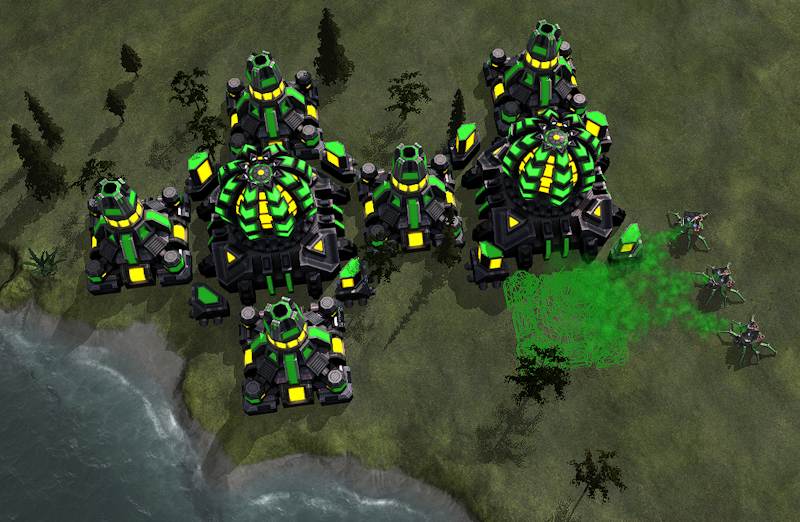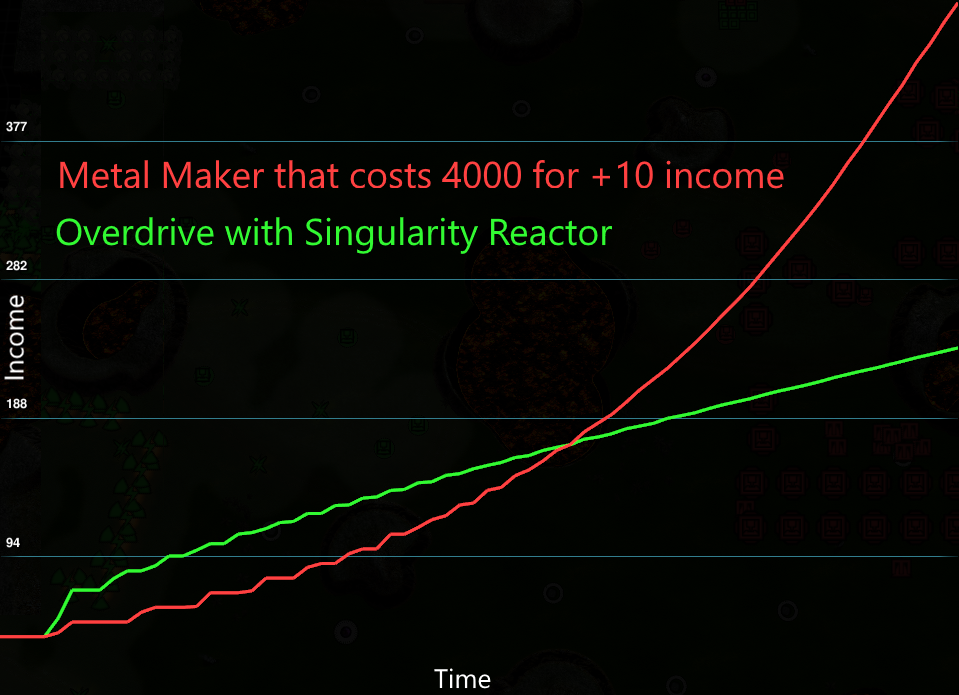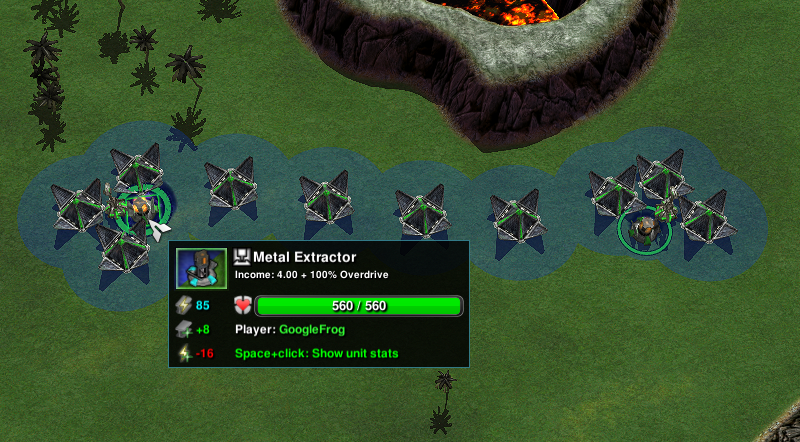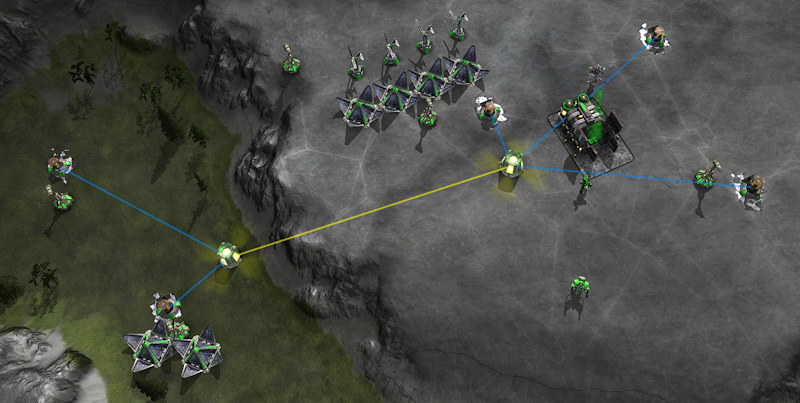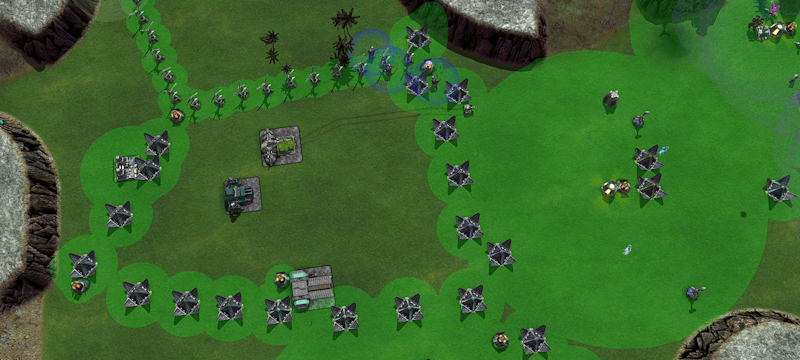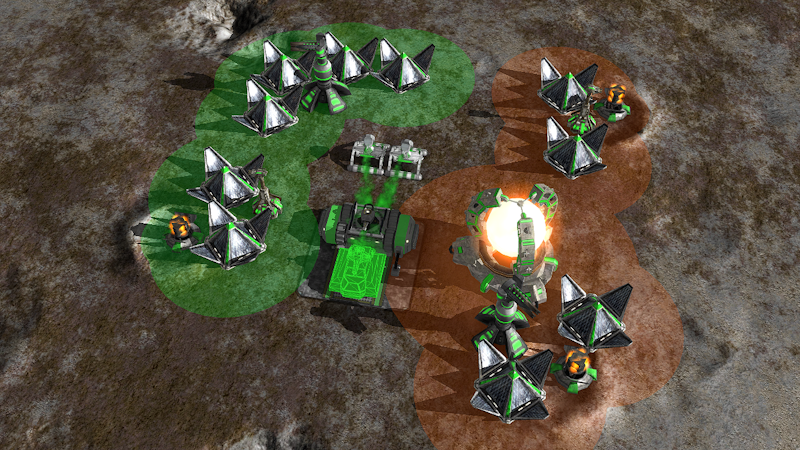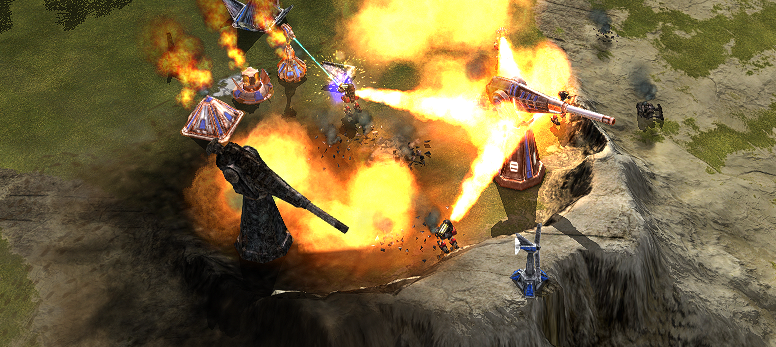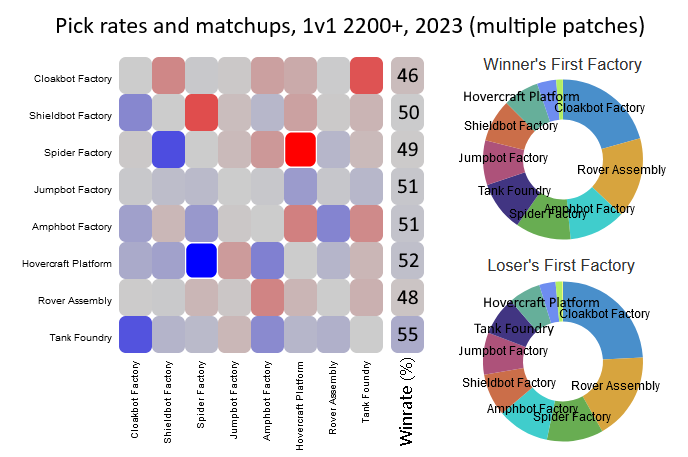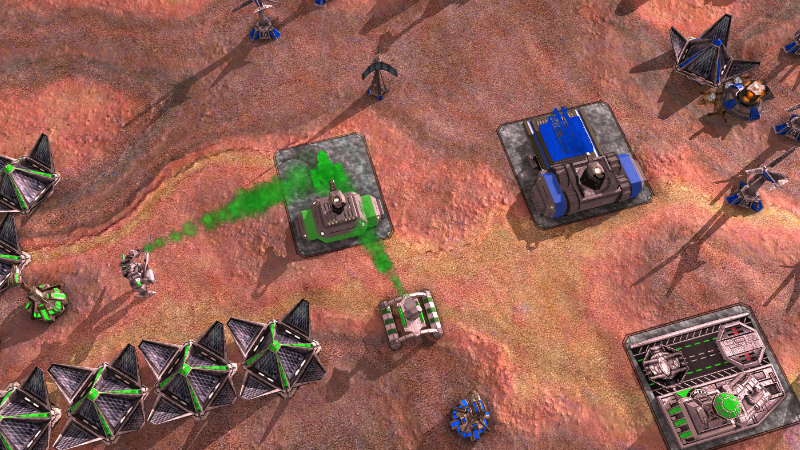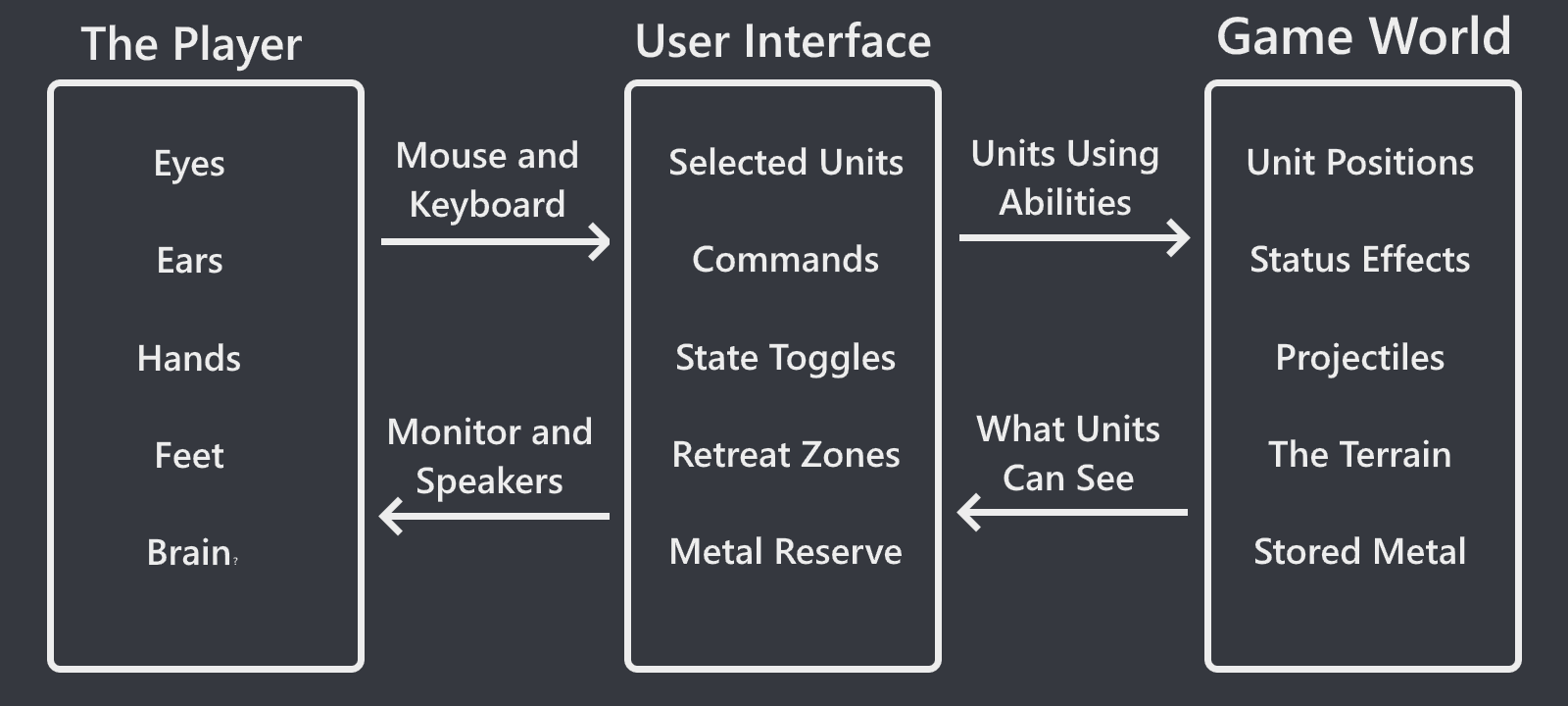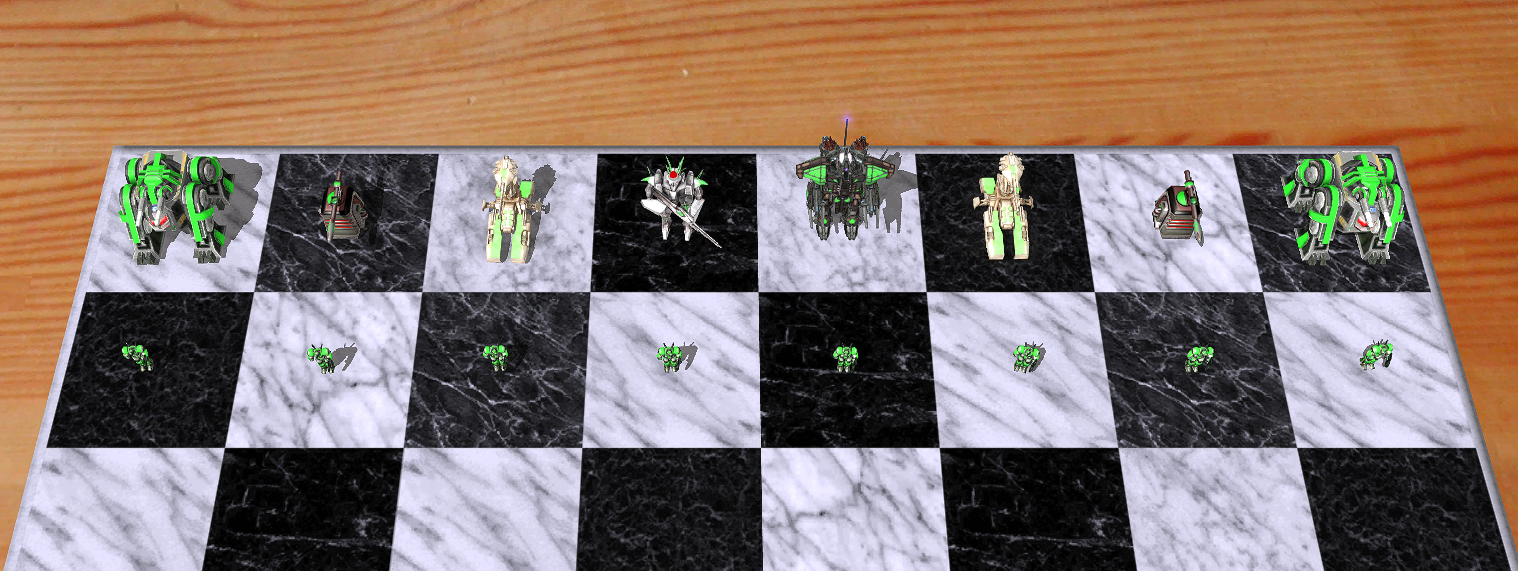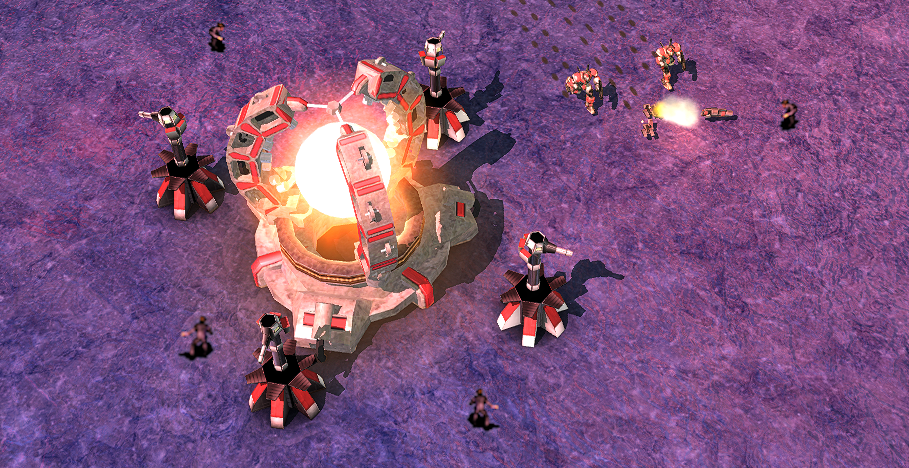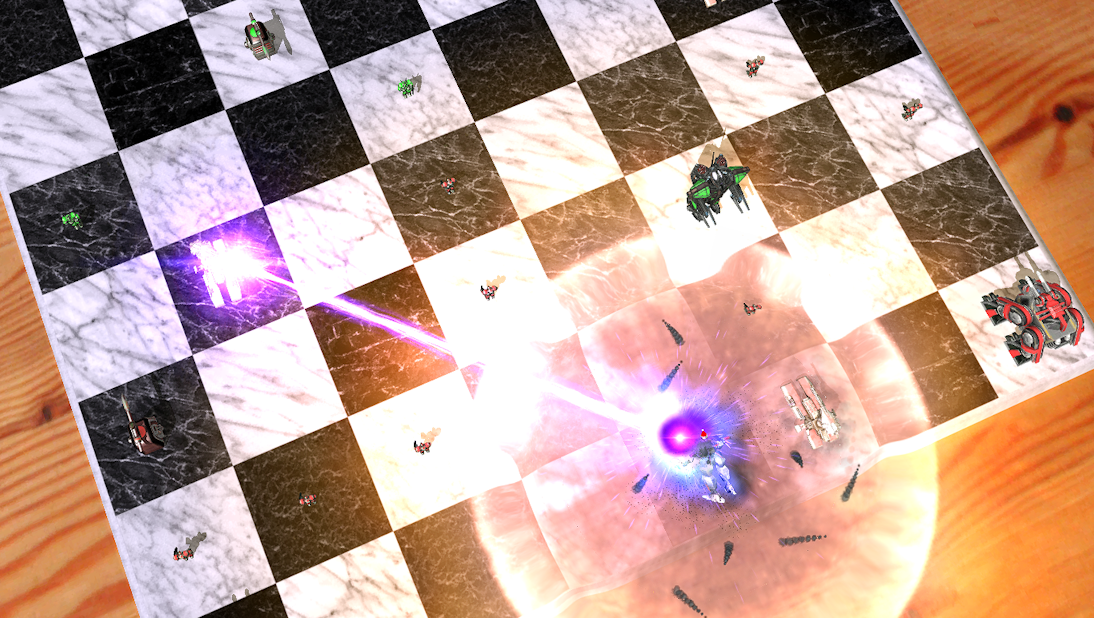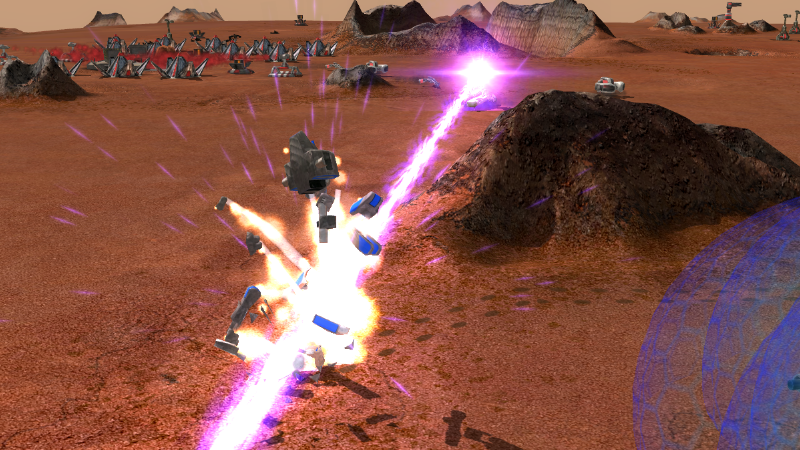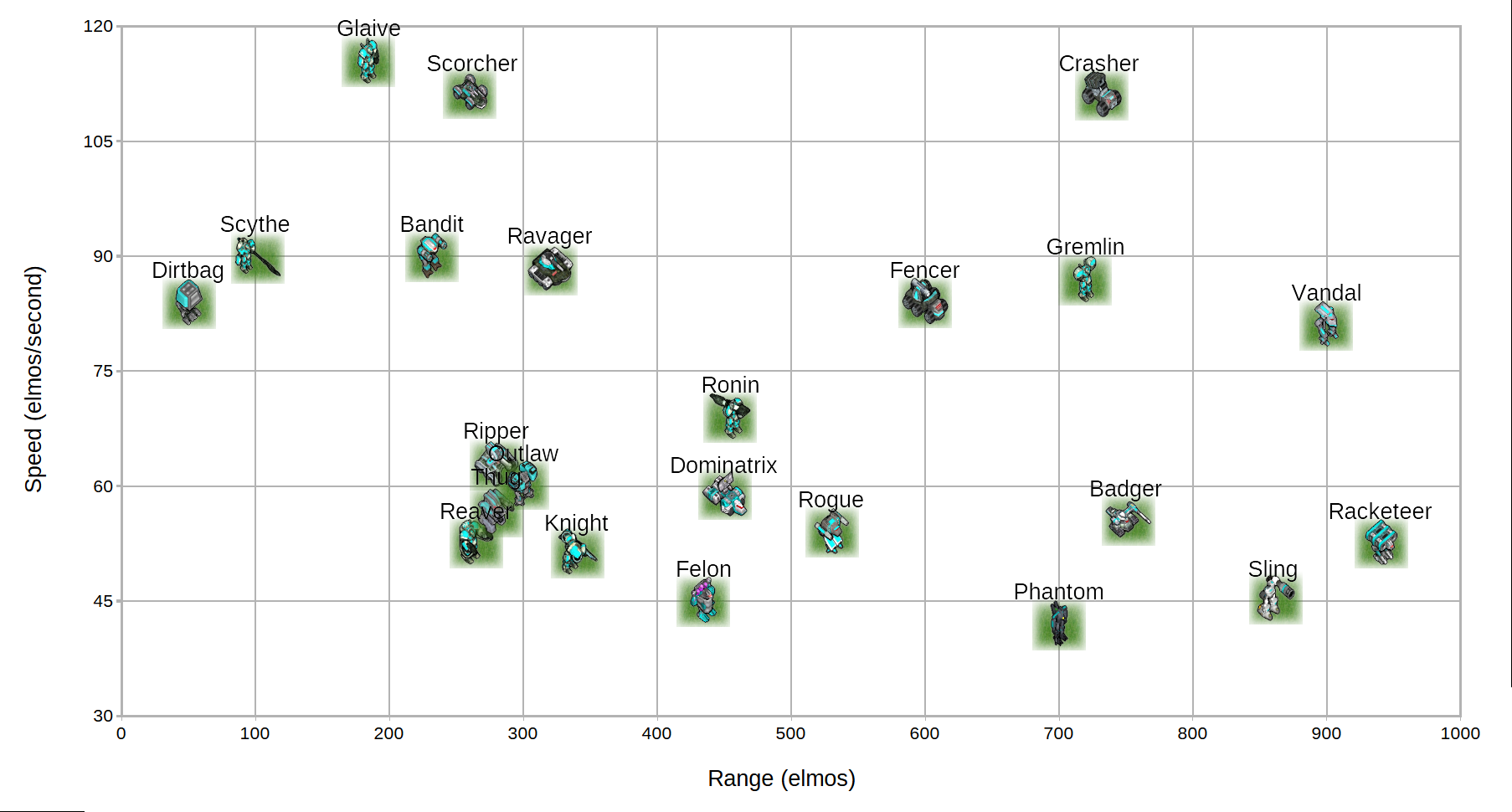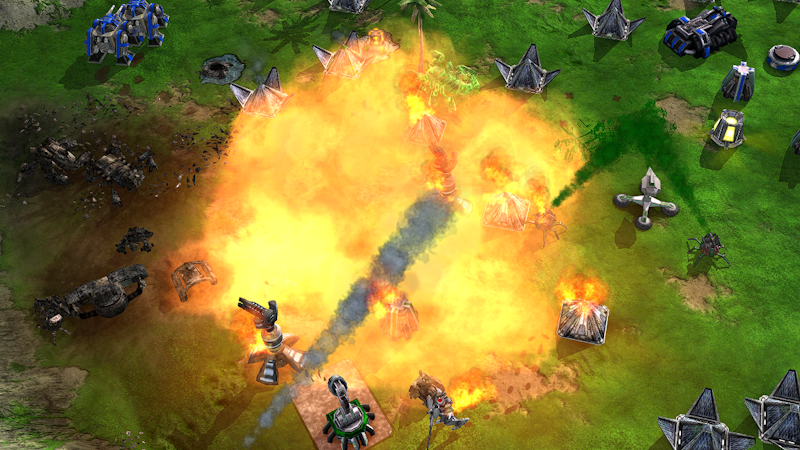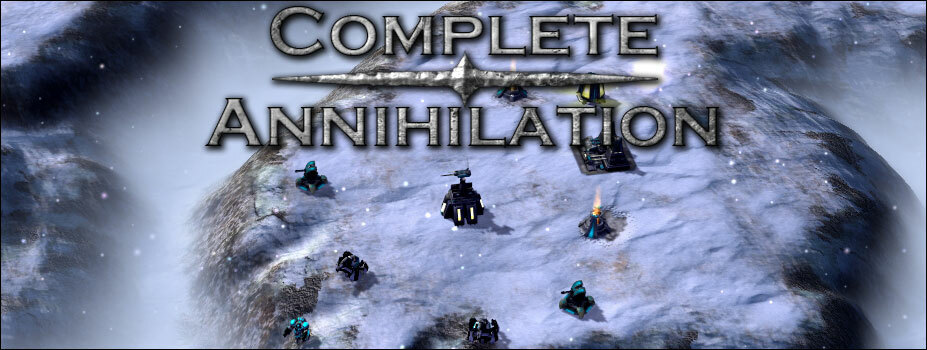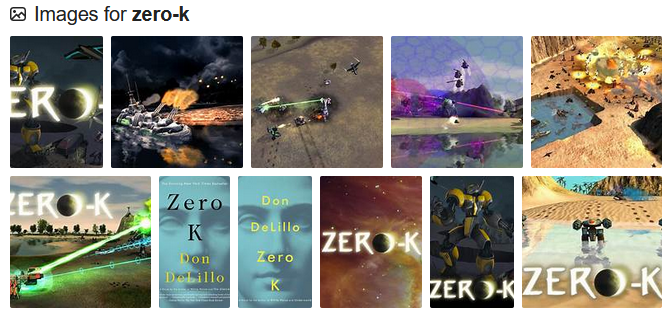
Feb 10, 2024
Zero-K - GoogleFrog
Projectiles in Zero-K are physically simulated, meaning that shots fly through the air and collide with anything that gets in the way. This is standard for games inspired by Total Annihilation, but Zero-K leans into the mechanic hard, and embraces the implications. Not content with taking only one thing to the extreme, Zero-K also has a strong aversion to armour classes and damage bonuses. We completely avoid damage formulas of the type that let pikemen deal extra damage to horsemen, or tanks take reduced damage from rifles. The goal is to create a game world that is visceral and intuitive, something that is best engaged with as a physical space, rather than as an abstract collection of numbers.
Complete Annihilation steadily removed the damage formulas inherited from Balanced Annihilation, and it looks like BAR might head the same way too. These were mostly things like commanders taking extra damage from turrets, and various EMP resistances. Bonuses like these suffer from being confusing and hard to remember, especially in a futuristic setting with no historical precedent or clear notion of infantry to guide intuition. Besides, completely removing damage bonuses is just so elegant, and making it work is a fun challenge. So we saw damage bonuses as a crutch, they solved problems in BA, but we could use physics to come up with better solutions.
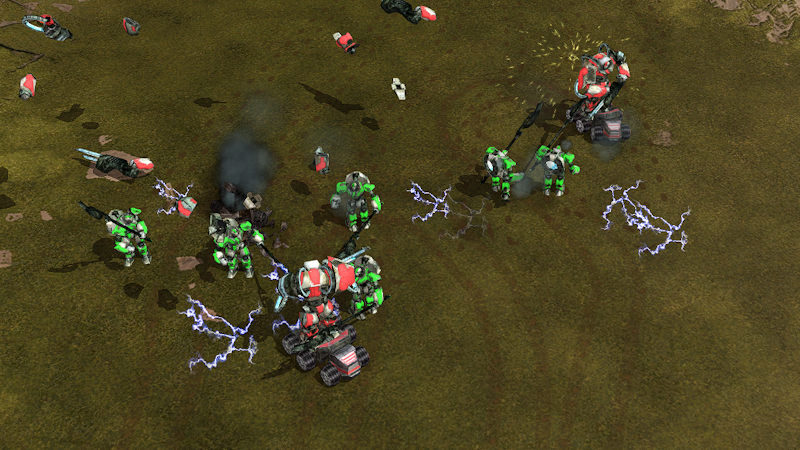
To stack hubris on hubris, we also wanted the units of CA to have roles. Roles in the sense of pikemen beating horsemen, which is a bit more detailed than the roles found in Total Annihilation and most of its progeny. The roles in TA tend to be big "theatre of war" style designations, with roles like "bomber", "fighter", "scout" and "artillery". These roles are about dominating air, land or sea, or about projecting force from one domain to another. Artillery even fits this description if you consider bases and open ground to be different domains. In any case, all this theatre-on-theatre action left little room for diversity within a domain. This limits the options for combat within a domain, and in particular, land armies designed to fight other land armies could end up quite similar. The generic "army unit" would change as the game escalated, but at any given point the unit selection felt slim.
Armies in Zero-K should consist of multiple unit types, and it should be possible to exploit deficiencies of enemy armies, all within the ground vs. ground game. So Zero-K is designed around roles. Fast light raiders beat ranged skirmisher, which beat slow beefy riots, which beat fragile raiders. Whether these are "hard counters" or not mostly depends on how you define "hard", but I think they are mostly soft counters. Units can often beat their counters with a slight numbers advantage and a good engagement. We still have the "theatre of war" style roles, since cross-domain interactions are great too, but these counters tend to be harder. Artillery is very good against static defense, and fighters are very good against bombers.
How does Zero-K have such roles, all without any bonus damages? What makes the horseman-equivalent particularly bad against the pikeman-equivalent? In many cases, the answer is physics. Game physics, not real world physics, as the goal is depth rather than realism. Physics means the way units move around the world and interact with each other. It is things like unit positions, ranges and speeds, weapon area of effect damage, and how projectiles move. This is not new, every RTS has physics, and without it they would essentially be spreadsheets. Physics is fundamentally what gives players any reason to care where anything is. Every game with time, space, and simple rules linking them together has some sort of physics.
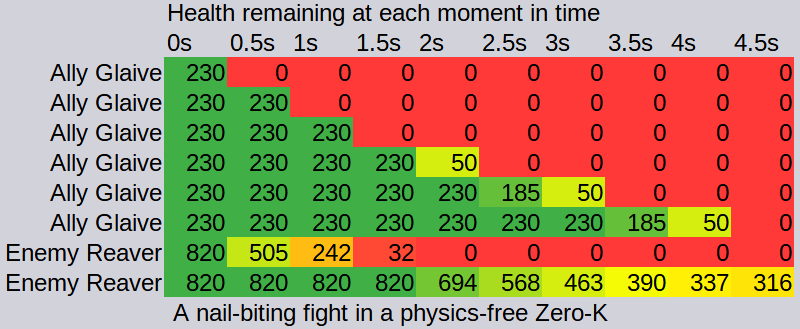
Not only is physics used by every RTS, it is often a large part of their design and balance. Horsemen counter archers because speed physically counters range, and any arrow-resistant armour is just icing on the cake. Zero-K just takes this a step further, eschewing damage modifiers and relying more on physics instead. This is a design constraint, a rule we have set for ourselves, because it means that units need to be physically different to have different roles. Spearmen can be designed to counter horsemen with physics alone, but it becomes tricky when it is time to implement a physically similar swordsmen. There is still plenty of freedom though, since quite a bit can be done with basic stats such as speed, health, damage and range. On top of this, Zero-K uses projectile physics to a much greater extent than the average RTS.
In most games, units shoot projectiles as a form of delayed damage, and to animate the act of shooting. A standard projectile will hit its target, and nothing else, unless the target does something weird (such as dying or, in some cases, teleporting). In Zero-K, each projectile is an independent entity with its own physics. Plasma cannon shots arc through the air, lasers fire in straight lines, and missiles try to track their target. If a projectile hits something, anything, then it explodes and deals its damage. The visuals are used to convey all this, rather than just being an animation to show that a unit shot.
Projectile physics increases the importance of units' speed and model size. Many longer ranged weapons shoot slow or inaccurate projectiles, which gives small fast units a chance to dodge while closing in. The slow rockets of most skirmishers are tuned to hit large assaults and riot units. In turn, the even slower projectiles of assaults and artillery units give most targets a chance to dodge, with the notable exception being turrets. There is space for soft counters here. Skirmishers can still beat fast raiders, but it is more a matter of creating a blizzard of rocket fire than having individual skirmishers fire at and hit individual raiders.

The whole "Physics vs. Formulas" dichotomy is about which parts of the game are more important. It is about whether a player choosing which unit to build thinks more about how it moves and shoots, or about damage formulas that determine what it counters. Zero-K is on the side of physics because it is cool, and it seems so intuitive. Players can see whether a projectile hits a unit and extrapolate the results for other projectiles and units of a similar speed. On the other hand, formulas are invisible and can be arbitrarily complex, taking into account armour, unit type, weapon type, and upgrades. Enough of a reliance on formulas can make the physics of a battle irrelevant, which is a shame because it is the part of the game that players can interact with moment-to-moment. Exploiting a formula is more down to unit choice than unit usage.
Great mechanics have more than one purpose, and physics of Zero-K has many. A big one is to fight Lanchester's square law, which essentially says that an army of twice the size is four times as powerful. All games have to grapple with this law, that is, unless they are happy with players just rolling a big ball of units around the map. The trick to fighting Lanchester's square law is that the "square" only applies in ideal situations, so to fight it we just need to move away from the ideal. Most games do this via units of inconveniently short range, to limit what can fire, and area of effect damage, as it deals more damage to dense armies - armies which are dense because everything is trying to get into range. Zero-K makes use of these approaches, but uses projectile physics to add even more.
Unguided projectiles act a bit like area of effect damage, because dense forces take more hits. Consider how a large force of Ronin will fire more rockets than a smaller force, but also runs into more rockets. At least, unless the Ronin spread out, but that risks moving some too far away to shoot. This all fights Lanchester's square law, but in a dynamic way where there are tradeoffs between dealing and taking damage. A small force can hold off a large one for a while if the larger army is unwilling to take any damage. It also makes attacking from multiple angles even better, since it reduces your own density. But perhaps the most notable effect of simulating projectiles comes from allied units blocking each other.

Projectiles hit units regardless of their allegiance, and going this far with projectile physics is rare even among games inspired by TA. It means that a dense blob of units loses most of its damage to blocked lines of fire. This further encourages armies to spread out in a line. Density and facing is very important, since a good flank can leave most of an army unable to return fire, even if they are in range. High density is not all bad though, since it concentrates power and prevent units being surrounded by enemy raiders, so there is a constant tradeoff. Still, Zero-K tends to have lower density armies than the average game, which encourage spread out battles across multiple fronts. The advantages of low density even play a central role in the escalation from cheaper to more expensive units.
Projectiles have a lot of parameters, which in turn allows for a large range of weapon types. To cut down on complexity, most weapons fall into one of three categories.
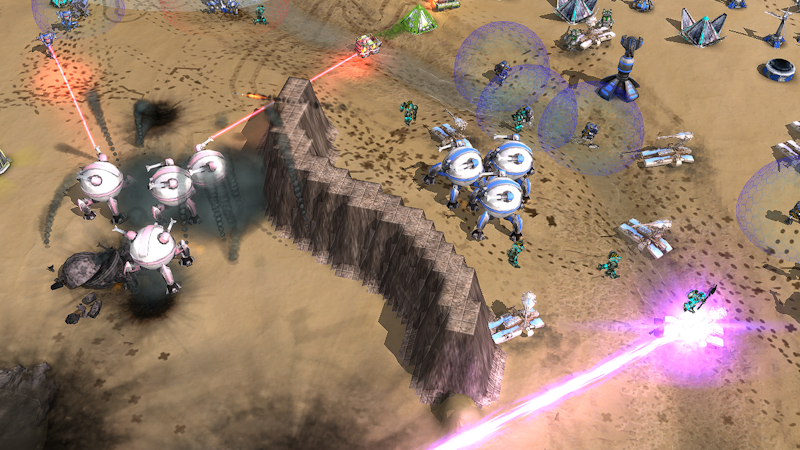
This all sounds great, hopefully, but it also sounds fiddly. Luckily, Zero-K is built on fighting your opponent, not the UI, so we are careful to keep the physics manageable. We avoid implementing unnecessarily fiddly weapons, and provide powerful controls to deal with everything else. Line Move lets players create formations and dial in their density with ease, and becomes their default way of issuing orders. Attack Move lets players tell short ranged units to jink around to avoid projectiles, and longer ranged units to move away from enemies that try to close range. Anti-Bait lets players tell units with big important shots to not waste their time trying to hit a speedy raider. And it almost goes without saying that units have the intelligence not to fire when allies or terrain is in the way.
I have been a bit misleading, and it is time to come clean. Zero-K has a damage formula. To start with, some units have an armoured mode that causes them to take 33% damage. I am not sure whether this counts though, since the multiplier applies uniformly. The most common damage modifier is for anti-air, which deals only 10% of its damage against ground units. But anti-air is not even capable of firing at ground units, which is a fine mechanic provided the target categories are clear. The anti-air damage modifier is mostly just insurance against anyone figuring out how to work around this restriction. Then there are shields, which have to convert status effect damage such as EMP and slow to ordinary damage. This is done at a rate of 33%, which is a bit arbitrary, but it has to be less than 100% because status effects have very high raw damage. Finally, gauss and flamethrowers deal extra damage to shields, because something something piercing something something... there is actually no excuse.
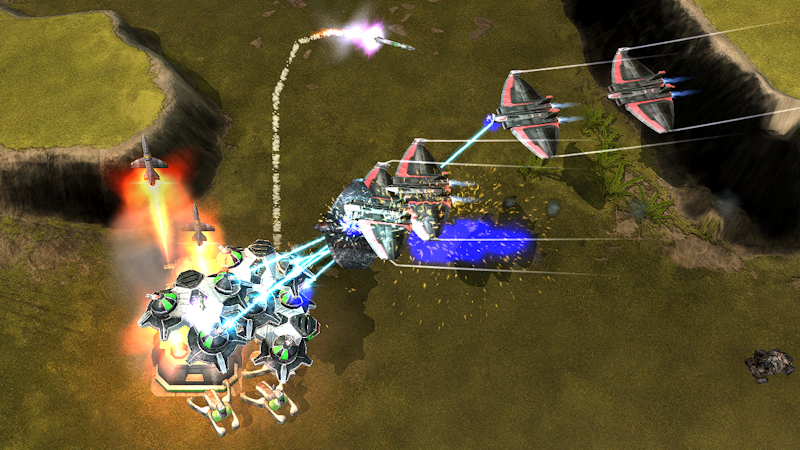
It gets worse though, as some units shoot through allies, or even terrain. And not in a consistent way, like how flamethrowers burn through everything in their path. Nukes and tacnukes pass through allies because having one explode on an errant plane sucks (although when they hit an enemy plane it is hilarious). Anti-nukes pass through everything for similar reasons, but also because they do not know how to try again if an anti-nuke misses its target. A few other weapons here and there pass through allies, although in most of these cases units still avoid shooting at allies. There is a difference between colliding at allies and firing at allies. A few units with fast ally-piercing projectiles still aim as if they would hit allies, so the caveat is more about edge cases. Some edge cases are bad, and the best uses of physics know when to relax and let things feel good. In short, know when to dial back the jank, because sometimes it just sucks.
Speaking of jank, weapons can impart force on units, pushing them around. Clearly this means there should be gravity gun weapons that just push or pull units, and there is no reason not to let it target allies. The result is unit cannons made of Newtons (the gravity gun turret) and terraformed ramps, and it is my favourite incarnation of a unit cannon. Anything can be fired, anything, provided you have the resources and skill at engineering. Such a thing would get repetitive if it were common, but somehow it hits a sweet spot. It is often impractical, but sometimes it is time to fling Jacks into the back of the enemy base.
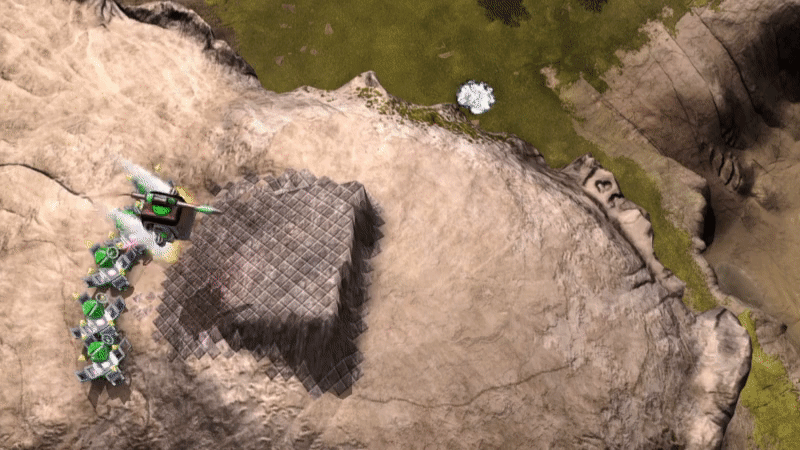
Gravity guns and edge cases aside, the goal of Zero-K's physics is to evoke a particular feel. The game world should feel like something that should be engaged with as a physical space, rather than an abstract collection of numbers and circles. Games can end up feeling quite abstract. Put more enemy units in your circles (ranges and spell radii) than your opponent manages to put in theirs, and you win. Formulas can vary the effect and suitability of each circle, but this just mixes up which circles are used, rather than change the fact that everything is circles. Zero-K fundamentally disrupts the circles, deforming them into weird and wacky shapes, the consequences of which are too numerous to cover in one article. But it is sure to come up again and again.
Index of Cold Takes
Complete Annihilation steadily removed the damage formulas inherited from Balanced Annihilation, and it looks like BAR might head the same way too. These were mostly things like commanders taking extra damage from turrets, and various EMP resistances. Bonuses like these suffer from being confusing and hard to remember, especially in a futuristic setting with no historical precedent or clear notion of infantry to guide intuition. Besides, completely removing damage bonuses is just so elegant, and making it work is a fun challenge. So we saw damage bonuses as a crutch, they solved problems in BA, but we could use physics to come up with better solutions.

To stack hubris on hubris, we also wanted the units of CA to have roles. Roles in the sense of pikemen beating horsemen, which is a bit more detailed than the roles found in Total Annihilation and most of its progeny. The roles in TA tend to be big "theatre of war" style designations, with roles like "bomber", "fighter", "scout" and "artillery". These roles are about dominating air, land or sea, or about projecting force from one domain to another. Artillery even fits this description if you consider bases and open ground to be different domains. In any case, all this theatre-on-theatre action left little room for diversity within a domain. This limits the options for combat within a domain, and in particular, land armies designed to fight other land armies could end up quite similar. The generic "army unit" would change as the game escalated, but at any given point the unit selection felt slim.
Armies in Zero-K should consist of multiple unit types, and it should be possible to exploit deficiencies of enemy armies, all within the ground vs. ground game. So Zero-K is designed around roles. Fast light raiders beat ranged skirmisher, which beat slow beefy riots, which beat fragile raiders. Whether these are "hard counters" or not mostly depends on how you define "hard", but I think they are mostly soft counters. Units can often beat their counters with a slight numbers advantage and a good engagement. We still have the "theatre of war" style roles, since cross-domain interactions are great too, but these counters tend to be harder. Artillery is very good against static defense, and fighters are very good against bombers.
How does Zero-K have such roles, all without any bonus damages? What makes the horseman-equivalent particularly bad against the pikeman-equivalent? In many cases, the answer is physics. Game physics, not real world physics, as the goal is depth rather than realism. Physics means the way units move around the world and interact with each other. It is things like unit positions, ranges and speeds, weapon area of effect damage, and how projectiles move. This is not new, every RTS has physics, and without it they would essentially be spreadsheets. Physics is fundamentally what gives players any reason to care where anything is. Every game with time, space, and simple rules linking them together has some sort of physics.

Not only is physics used by every RTS, it is often a large part of their design and balance. Horsemen counter archers because speed physically counters range, and any arrow-resistant armour is just icing on the cake. Zero-K just takes this a step further, eschewing damage modifiers and relying more on physics instead. This is a design constraint, a rule we have set for ourselves, because it means that units need to be physically different to have different roles. Spearmen can be designed to counter horsemen with physics alone, but it becomes tricky when it is time to implement a physically similar swordsmen. There is still plenty of freedom though, since quite a bit can be done with basic stats such as speed, health, damage and range. On top of this, Zero-K uses projectile physics to a much greater extent than the average RTS.
In most games, units shoot projectiles as a form of delayed damage, and to animate the act of shooting. A standard projectile will hit its target, and nothing else, unless the target does something weird (such as dying or, in some cases, teleporting). In Zero-K, each projectile is an independent entity with its own physics. Plasma cannon shots arc through the air, lasers fire in straight lines, and missiles try to track their target. If a projectile hits something, anything, then it explodes and deals its damage. The visuals are used to convey all this, rather than just being an animation to show that a unit shot.
Projectile physics increases the importance of units' speed and model size. Many longer ranged weapons shoot slow or inaccurate projectiles, which gives small fast units a chance to dodge while closing in. The slow rockets of most skirmishers are tuned to hit large assaults and riot units. In turn, the even slower projectiles of assaults and artillery units give most targets a chance to dodge, with the notable exception being turrets. There is space for soft counters here. Skirmishers can still beat fast raiders, but it is more a matter of creating a blizzard of rocket fire than having individual skirmishers fire at and hit individual raiders.

The whole "Physics vs. Formulas" dichotomy is about which parts of the game are more important. It is about whether a player choosing which unit to build thinks more about how it moves and shoots, or about damage formulas that determine what it counters. Zero-K is on the side of physics because it is cool, and it seems so intuitive. Players can see whether a projectile hits a unit and extrapolate the results for other projectiles and units of a similar speed. On the other hand, formulas are invisible and can be arbitrarily complex, taking into account armour, unit type, weapon type, and upgrades. Enough of a reliance on formulas can make the physics of a battle irrelevant, which is a shame because it is the part of the game that players can interact with moment-to-moment. Exploiting a formula is more down to unit choice than unit usage.
Great mechanics have more than one purpose, and physics of Zero-K has many. A big one is to fight Lanchester's square law, which essentially says that an army of twice the size is four times as powerful. All games have to grapple with this law, that is, unless they are happy with players just rolling a big ball of units around the map. The trick to fighting Lanchester's square law is that the "square" only applies in ideal situations, so to fight it we just need to move away from the ideal. Most games do this via units of inconveniently short range, to limit what can fire, and area of effect damage, as it deals more damage to dense armies - armies which are dense because everything is trying to get into range. Zero-K makes use of these approaches, but uses projectile physics to add even more.
Unguided projectiles act a bit like area of effect damage, because dense forces take more hits. Consider how a large force of Ronin will fire more rockets than a smaller force, but also runs into more rockets. At least, unless the Ronin spread out, but that risks moving some too far away to shoot. This all fights Lanchester's square law, but in a dynamic way where there are tradeoffs between dealing and taking damage. A small force can hold off a large one for a while if the larger army is unwilling to take any damage. It also makes attacking from multiple angles even better, since it reduces your own density. But perhaps the most notable effect of simulating projectiles comes from allied units blocking each other.

Projectiles hit units regardless of their allegiance, and going this far with projectile physics is rare even among games inspired by TA. It means that a dense blob of units loses most of its damage to blocked lines of fire. This further encourages armies to spread out in a line. Density and facing is very important, since a good flank can leave most of an army unable to return fire, even if they are in range. High density is not all bad though, since it concentrates power and prevent units being surrounded by enemy raiders, so there is a constant tradeoff. Still, Zero-K tends to have lower density armies than the average game, which encourage spread out battles across multiple fronts. The advantages of low density even play a central role in the escalation from cheaper to more expensive units.
Projectiles have a lot of parameters, which in turn allows for a large range of weapon types. To cut down on complexity, most weapons fall into one of three categories.
- Plasma cannon that fly through the air in a ballistic arc.
- Unguided rockets or homing missiles. Some are fired directly at the target, while others arc.
- Lasers and lightning that instantly hit and require a direct line of sight to fire.

This all sounds great, hopefully, but it also sounds fiddly. Luckily, Zero-K is built on fighting your opponent, not the UI, so we are careful to keep the physics manageable. We avoid implementing unnecessarily fiddly weapons, and provide powerful controls to deal with everything else. Line Move lets players create formations and dial in their density with ease, and becomes their default way of issuing orders. Attack Move lets players tell short ranged units to jink around to avoid projectiles, and longer ranged units to move away from enemies that try to close range. Anti-Bait lets players tell units with big important shots to not waste their time trying to hit a speedy raider. And it almost goes without saying that units have the intelligence not to fire when allies or terrain is in the way.
I have been a bit misleading, and it is time to come clean. Zero-K has a damage formula. To start with, some units have an armoured mode that causes them to take 33% damage. I am not sure whether this counts though, since the multiplier applies uniformly. The most common damage modifier is for anti-air, which deals only 10% of its damage against ground units. But anti-air is not even capable of firing at ground units, which is a fine mechanic provided the target categories are clear. The anti-air damage modifier is mostly just insurance against anyone figuring out how to work around this restriction. Then there are shields, which have to convert status effect damage such as EMP and slow to ordinary damage. This is done at a rate of 33%, which is a bit arbitrary, but it has to be less than 100% because status effects have very high raw damage. Finally, gauss and flamethrowers deal extra damage to shields, because something something piercing something something... there is actually no excuse.

It gets worse though, as some units shoot through allies, or even terrain. And not in a consistent way, like how flamethrowers burn through everything in their path. Nukes and tacnukes pass through allies because having one explode on an errant plane sucks (although when they hit an enemy plane it is hilarious). Anti-nukes pass through everything for similar reasons, but also because they do not know how to try again if an anti-nuke misses its target. A few other weapons here and there pass through allies, although in most of these cases units still avoid shooting at allies. There is a difference between colliding at allies and firing at allies. A few units with fast ally-piercing projectiles still aim as if they would hit allies, so the caveat is more about edge cases. Some edge cases are bad, and the best uses of physics know when to relax and let things feel good. In short, know when to dial back the jank, because sometimes it just sucks.
Speaking of jank, weapons can impart force on units, pushing them around. Clearly this means there should be gravity gun weapons that just push or pull units, and there is no reason not to let it target allies. The result is unit cannons made of Newtons (the gravity gun turret) and terraformed ramps, and it is my favourite incarnation of a unit cannon. Anything can be fired, anything, provided you have the resources and skill at engineering. Such a thing would get repetitive if it were common, but somehow it hits a sweet spot. It is often impractical, but sometimes it is time to fling Jacks into the back of the enemy base.

Gravity guns and edge cases aside, the goal of Zero-K's physics is to evoke a particular feel. The game world should feel like something that should be engaged with as a physical space, rather than an abstract collection of numbers and circles. Games can end up feeling quite abstract. Put more enemy units in your circles (ranges and spell radii) than your opponent manages to put in theirs, and you win. Formulas can vary the effect and suitability of each circle, but this just mixes up which circles are used, rather than change the fact that everything is circles. Zero-K fundamentally disrupts the circles, deforming them into weird and wacky shapes, the consequences of which are too numerous to cover in one article. But it is sure to come up again and again.
Index of Cold Takes




